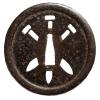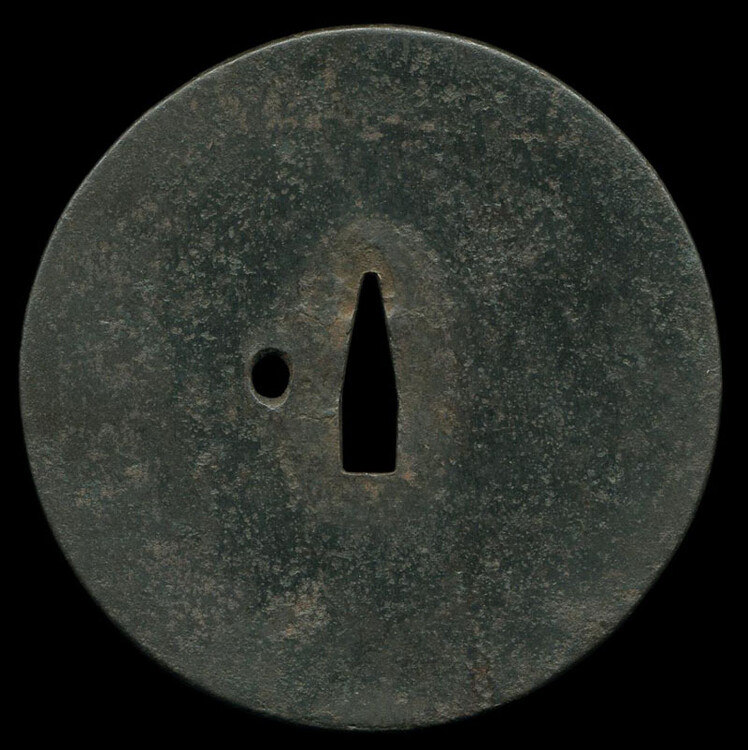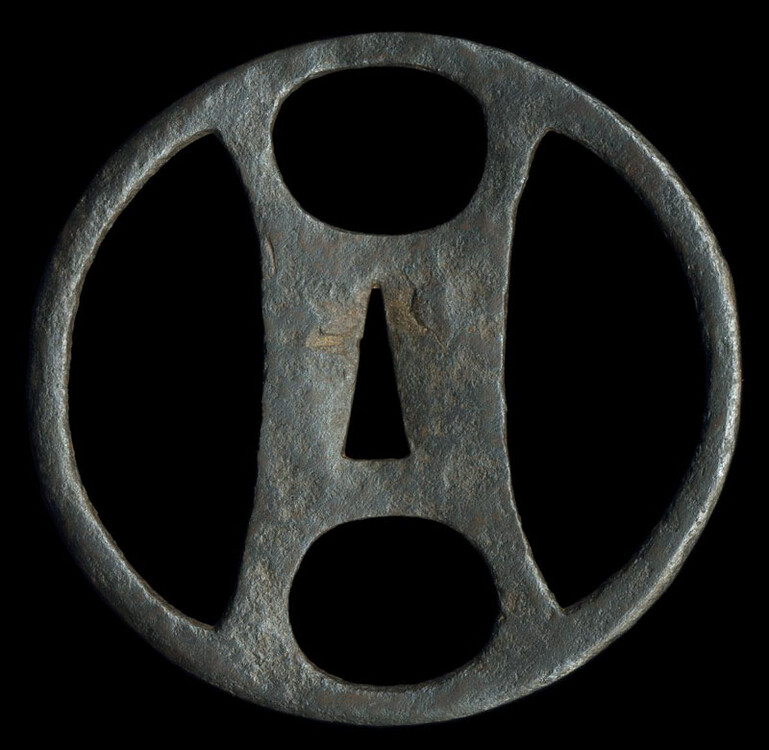-
Posts
193 -
Joined
-
Last visited
Everything posted by BMarkhasin
-
Markus, Your book arrived and I have had a chance to peruse it. Very organized, comprehensive and well illustrated compilation detailing the diversity and development of koshirae from Yayoi to modern times. I thought you provided some great detail on some of the more obscure and transitional early koshirae - an area of personal interest. I encourage others to buy this book. Best Regards, Boris.
-
Hi everyone, This is a bit off topic for a nihonto board, but Brian has permitted me to petition the membership through this section. Before I started seriously collecting Japanese, I was interested in Chinese bronze (Han and earlier), acquiring originals before the market was flooded with fakes in the mid/late 90's. I am in the process of a near total collection clean-out, and I have a small but high quality Chinese archaic bronze collection for sale as well - roughly 20 pieces. Items span mirrors, halberds / edged weapons, agraffes (garment hooks), axle caps, vessels and of course a small library. Its too early to post individual items, so I am just testing interest levels (if any) at this point. Please respond to this thread or PM if there is any interest. Thanks. Best Regards, Boris.
-
Thanks gents for the replies. Markus, I have purchased the book online for further reference. My particular interest lies in the species of handachi (Momoyama period) with a single ashikanamono near the koiguchi. I assume the second ashikanamono would have been the removable type. Attached is an image of an Edo handachi koshirae with two (assumed) removable ashikanamono. Sorry for the granular image, its from a general interest book I don't yet have. Best regards, Boris.
-
Gents, To rekindle this old thread, does anyone have images or illustrations of how a handachi with a single suspension ring was worn? Seems to me that two rings were needed to be able to imitate a tachi suspension for a handachi. I have not seen evidence of more than the single suspension ring being used. best, Boris
-
This style of kashira is termed "toppai". Below is a link to another example. http://www.yamabushiantiques.com/TSUKA4.htm Best, Boris.
-
Richard, I have a bunch of extras you can have. Email me. Best, Boris
-
Hi everyone, I have been in asia on business over the last week and did not have time to check emails. I checked today, answering everything I missed, but didn't have any emails or voicemails from either of you guys... If anyone tries to email YBA and dont get a response within 24 hours, please resend. This is not my day job, and I am frequently traveling. I will get back to you as soon as time permits. Thanks for your understanding. Best Regards, Boris
-
Craig, I am saddened by the closure of site, as the current circumstances as you described. It has been a pleasure and learning experience over the years to have shared our common interest in old soft metal. I hope as others have also expressed, that you continue to participate and contribute to this forum as well as stay in touch directly. Wishing you the best, Boris.
-
You can find the book used on Amazon for about $35 occasionally. It is in French, but the section on tsuba is quite understandable. The full title of the book is: Le San Diego: Un Tresor Sous La Mer. Dominique Carre. Reunion des Musees Nationaux. Paris. 1994. ISBN 2-7118-3135-3. Best, Boris.
-
Edward, As others have pointed out, Q86 is a kokinko tsuba, likely dating to the latest Muromachi to Momoyama period. The two mon are stamps, as was common in the period and this style of tsuba. These were made for the mass market and were basically mass produced, with minor differences in the treatment of the plate. It is almost certainly made of yamagane. I suspect the hitsu-ana is actually original. It retains a considerable amount of lacquer on the plate, so dont attempt to clean it outside of a very soft toothbrush and warm water to get rid of any surface grunge. You may want to apply a light choji oil coating with a soft cotton cloth if you feel the patina and remnant lacquer looks overly dry. Best, Boris.
-
Inlay of semi-precious stones and minerals, coral, glass, ivory, lacquer and wood is not uncommon in Japanese metalwork. I think the most commonly encountered works with such inlay belong to the Hamano school, while enamel inlays are most often associated with Hirata school works. I suspect the full list of schools / artists dabbling in these techniques is lengthier. The practice of inlaying non-metallic (exotic) substances dates back to the late Kofun / Asuka periods, with the techniques imported from Korea and China. Preserved early examples are extremely rare. The vast majority of inlayed tosogu works collectors encounter date to the 18th and 19th century, while Hirata inlays may go back to the late 16th c. The Baur, Joly, Rosin and numerous other collections contain exceptional examples of such inlays. Best, Boris.
-
Curt, I will echo the opinions of other members regarding this set of menuki, but its not a bad starting point - simple but authentic and meritous of some study, especially since they are your first. Most seasoned collectors have turned over their collections several times in efforts to upgrade or branch-out, and this will happen to you as well. Learn what you can, and move on to better pieces. Try to avoid ebay, as its full of misinformation and fakes. Go for some of the Japanese sites which offer good quality items with far less risk of acquiring something fake. Most of us started with Aoi Arts (see commercial lists on the NMB). Its a great place to acquire good entry to mid-grade pieces, and the descriptions often offer some good insights to kantei points as well, so you will learn as you shop. And definately try to attend a US show in the near future. Good luck. Best, Boris.
-
Gents, I am not a nihonto collector, and only have a historical interest and appreciation in blades. To this effect, I will not enter into this debate. However from the perspective of a seasoned tosogu collector, it strikes me that we are losing perspective on the value of habaki. Lets not lose sight of the fact that a habaki is a quintessential tosogu element, having both a key functional role, as well as being an artistic element. Habaki have been around since the invention of the curve. We however have totally disregarded them from our collections and studies. We strive to attain Heian through Nanbokucho blades, but we don't realize that although extremely rare, there are examples of period habaki which have survived. I think this goes back to the point that a member made about swords generally being better maintained and far less frequently polished historically. I suggest that before discarding habaki, or replacing them, we take the time to study them and make an educated judgement if they are simple later functional pieces, or if they have age and warrant preservation in their own right. Although collections of habaki are rare and unusual, some of the best are owned by those associated with papering organizations as well as polishers. These I can only assume were removed from submissions, and owners who did not care enough or know enough about their historic habaki to retain them. For what its worth, there are my two yen. Best Regards, Boris.
-
You crack me up Curran! Thats exactly what it looks like!! How could I have missed that..... :lol: Mariusz, if soft metal is effeminate... a token iron widget (albeit a superb one) wont help you my friend. Best, B
-
Some good stuff being posted. Jason, I am using my trusty old Epson 500 scanner with no colour correction -- Epson is the only way to go unless you get Richard George to photograph your pieces. Curran, Bob, the acquisition of the 'steering wheel' is a good story. I was on an offshore rig in west Africa in 2002 killing time checking out Aoi Arts site. I clicked once, then again and this thing popped-up. I nearly fell out of my chair! I used the satellite phone to call Aoi and then my bank in Canada to wire funds. The calls alone cost nearly $500 (billed to the company of course). Tsuruta-san said that was the fastest sale he ever made - less than 2 minutes on the site. It remains my favourite iron piece in over 20 years of collecting. To put the size into perspective, it is virtually identical to a cd. I am with you Curran on Mariusz' ko-Umetada's. I think the brass one in particular is lovely. It came from Mr. Bob Haynes, who mentioned that he thought it to be one of the oldest brass tsuba he had seen. Mariusz, hope you don't mind that disclosure... Best, Boris
-
I love these two tsuba which are likely both Odachi tsuba of the Nanbokucho to early Muromachi periods. The large koTosho is 10.1 cm x 10.1 cm x 0.35 cm seppadai. The 'steering wheel' tsuba is 11.5 x 11.7 cm x 0.4cm seppadai. They are both very large, totally ubu, simple, with exceptional metal and deep patina. Best, Boris
-
Jason, Ford is close to the mark. This is definately Mino bori, as characterized by deeply carved design, with essentially vertical walls. In very fine examples of early Mino work (koMino), the motif is actually undercut, giving the impression that the motif is floating above a fine nanako-ji. This work is a bit later, but still early to mid Edo. It is very representative of the group. The menuki are Edo, and also Mino. Good find. PS -- this is an addition, as I had to leave my computer... To expound slightly, Mino work apart from being characterized by the vertical carving, also favoured floral motifs, especially flowers and vines, as well as insects and to a lesser degree animals. This Fuchi incorporates these 'kantei' points. The use of these motifs had a great longevity. Ultimately grades of Mino (and KoMino) works are judged and differentiated by the quality and depth of the mino bori technique, the application (and retention) of the gilding, the use of negative space among the high relief elements, and the quality of the nanakoji in the negative spaces. Determination of age is sometimes tough in Mino works, especially in the late Momoyama to early Edo. This makes my age determination a little speculative. I said early to mid Edo due to the general coarseness of the design and that it is quite generic. It lacks the vibrant quality of Momoyama works, and for lack of any better qualifiers, simply does not 'feel' like Momoyama work. I think early to mid Edo is a safe and supportable estimate. I think if you scoured a few books on the subject, you would come to the same conclusions. I'm not near my books now, but I am sure others could quickly suggest the best titles. I think one is Kinki Mino Bori (1973?), and there is another exhibition catalogue by Gifu Prefecture on the subject... Anyone? Best, Boris.
-
Marcello, Please don't get too eager to clean this tsuba. You are far more likely to damage the patina than improve it in any way. Often very light surface rust can be removed with a fine very soft bristle tooth brush and white soap. I am apprehensive to recommend any form of cleaning to anyone, so I refrain from further comment. This is a pleasant, reasonably early tsuba, but it is not considered a "ko-" or 'old' piece. This terminology is usually reserved for Pre-Momoyama tosogu, although often it is used for Momoyama period pieces as well. Being an Edo period piece, it is not a ko- piece. It can be considered katchushi due to the style of the rim loosely resembling kabuto suji and for the (likely) folded iron, but thats as far as you should go. Be happy with it for what it is, and if you paid an amount you are comfortable with, you are good. Edo katchushi pieces can vary considerably in price, but only in very rare circumstances do they fetch high prices. Focus on understanding the tsuba for its artistic and technical merits instead... Best, Boris.
-
Agreed on age and attribution -- early Edo, likely mid 17th c. katchushi tsuba. It has pleasing sukashi, a very nicely formed mimi, and the iron seems to be good quality. Best, Boris.
-
Fantastic work Ford! Thanks for illustrating the process -- very educational. You are giving me a great appreciation of the skill-set involved in making quality tosogu. However, I have a question (or 10...). In old menuki, there is occasionally evidence of sprues on the backs and rarely I have even seen minute porosity likely resulting from degassing. These observations are suggestive of a casting process leading to some partially formed intermediate product, which would then be worked further to achieve the desired levels of detail. What are your thoughts on this form of menuki manufacture? Thanks for the insights. Best Regards, Boris.
-
In my opinion, this tsuba likely dates to the early Edo, and is made of yamagane (or possibly copper) that has been patinated and by the look of it, black lacquered. The waves are typical kinko work, as well as the crude nanako. It appears like fairly common work of kinko artisans of the early to mid 17th c. I think its younger than the late Momoyama largely due to the rim and general feel of the piece, but it is not beyond the realm of possibility. The patina has been damaged where you see the more coppery colour coming through. DON'T mess with the remaining patina, you will only make it worse as Craig has already mentioned. Appreciate it as it is. Best Regards, Boris
-
I will be 39 this year. My interest was sparked when I was an extra in the samurai movie "Heaven and Earth" which was filmed in 1989 just outside Calgary. I spent 2 weeks marching and battling with yari in plastic armor! It was awesome. The production company had brought from Japan an authentic Muromachi domaru armor for one scene, and I had a chance to view it up close. I was hooked. Concurrently I discovered Ian Bottomley's book "Arms and Armor of the Samurai" as well as Robinson and Yumoto's entry level books. I read those books so often that my first set fell-apart from over-use. That year I bought my first tsuba in a local antique store -- I was 18. I still have the tsuba, and it remains one of my favourites. I have been collecting tosogu now for over 20 years, focussing more and more on the early material. I acquired my first armor in 2002. My very modest blade collection was acquired fairly recently, and consists of 1 daito, 1 tanto and some Kofun period tomb trash. Best Regards, Boris Markhasin.
-
Thanks for the welcome guys. Its nice to see some familiar names again. Best, Boris.
-
Gents, Here is a link to an ongoing auction featuring a nice late Edo period nerikawa tsuba. Note the deep black shiny lacquer, the high level of detailed craftsmanship and the crispness of the piece. It appears to be made of 2 possibly 3 thick layers. PS - I hope it was ok to post an ongoing auction here.... http://cgi.ebay.com/KAWA-TSUBA-Edo-old- ... 19bb25b87d Best Regards, Boris





